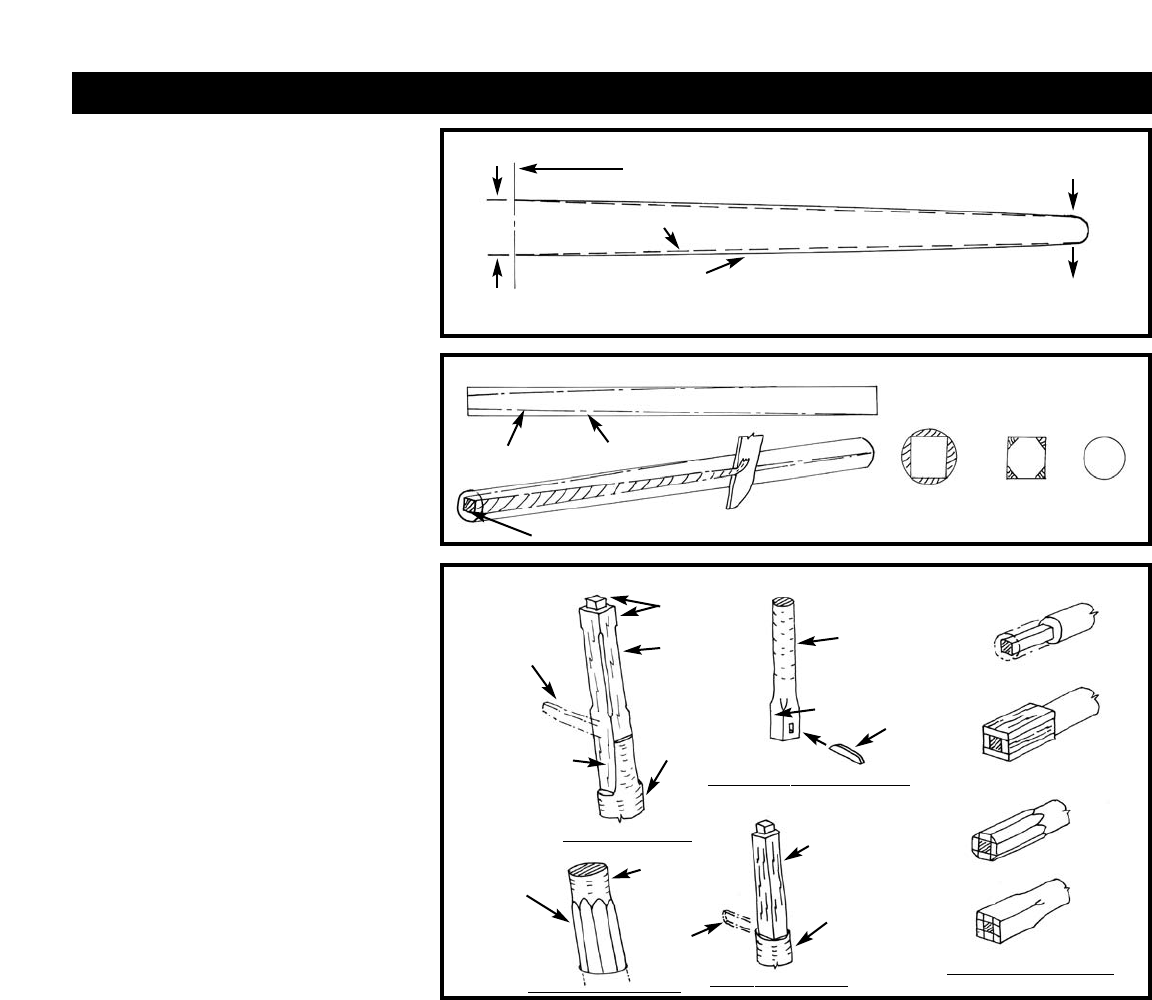
Most references call a mast a mast, and
anything else such as a boom, yard, gaff,
and bowsprit a spar. Let’s stick with
that definition.
There are two mast assemblies for the Dapper
To m . They are a foremast & main mast. The
foremast is built up in three sections: lower
mast, topmast, & topgallant mast. The main
mast is built up in only two sections: lower
mast & topmast. Each of the sections are con-
nected at the doublings (upper and lower
mast overlap) by mast caps and trestletrees
which in this kit are Britannia metal castings.
Lower mast trestletrees are supported from
the mast by bibbs (or cheeks) cut from wood
sheet. The castings for the trestletrees include
crosstrees and tops where appropriate, all in
one casting which eliminates a lot of assembly.
The mast and spar dowels included in the kit
are round. True to scale, masts and spars must
be tapered for their full length.
1. Shaping the Masts
Establishing the Correct Curve
of the Masts
The correct shape of the masts are shown on
the plans. Each of the mast sections should
be tapered in a slight (parabolic) curve (Fig-
ure E-1). However, for this kit scale, it may
be difficult to accomplish a parabolic shape.
A straight line taper should be sufficient.
The best way to taper the masts from dowels
is to cut the taper into squares, then
octagons, and finish by sanding into a round
shape (Figure E-2).
Shaping the Mastheads & Heels
The next areas of the masts to be shaped are
the mastheads and heels where the masts join
together at the doublings (see plans for loca-
tion). Each mast has a head and a heel
located at its uppermost and bottom ends,
respectively. The masthead on the lower
masts and fore topmast is from the trestle-
tr
ees up
ward to the cap.
T
o accommodate the mast caps and tr
estletr
ee
fittings, the mastheads must be shaped square.
The lower masts also have flat sides below the
trestletrees where the trestletree cheeks (also
called bibbs) ar
e to be glued.
The heel of the topmasts and topgallant mast
is round where it passes through the mast cap
at the top of the doubling and squar
e at the
bottom at the tr
estletr
ees.
The transition
from the square to the round portion is
shown on the plans. A fid (protruding bolt of
wood or iron) is located in each topmast and
topgallant mast heel to prevent them from
falling through the holes formed by the
trestletrees. The lower masts at the deck are
octagonal in shape. As an option the masts
could be left round.
Figure E-3 illustrates the shaping of the
mastheads, heels and the fid. Since you are
dealing with wood dowels, the sketch also
shows how to build the square or octagonal
ends by adding wood to the cut-end. Adding
wood is necessary because the dimension
across the flats of the square must be the
same as the dowel diameter. Consequently,
the diagonal of the square is greater than the
dowel diameter.
2. Assembling the Masts
First, install the lower mast top fitting, then
the topmast heel into the fitting. Make sure
you already have the fid installed into the
topmast heel. Then slide the mast cap over
the top mast and secure the cap onto the
lower masthead. Make sure the topmast lines
up straight with the lower mast when look-
ing fore and aft and that the two mast
sections are parallel when looking from the
side.
Y
ou can now glue the fittings. Assemble
the fore topgallant mast to the topmast in
the same manner.
Mast Details - Before painting and staining
the masts ther
e ar
e a fe
w details to add. The
fore topgallant mast and the main topmast
should have a shoulder where the lifts and
stays ar
e seiz
ed near the top of the mast. I
f
you have not tapered the masts with the
shoulder, do so now, or cut a groove at that
point.
This is needed so the rigging lines do
not slide down.
The topgallant and topsail tyes pass through
sheav
es in the masts. You don’t need a sheave
on the model, but drill a hole through the
masts for the lines.
The head of the fore topmast has a cheek
block port and starboard with two sheaves.
Make the block with stripwood and drill a
hole where the sheaves would be. The holes
on the starboard side are for passing the jib
10
STAGE E: MAST & SPAR CONSTRUCTION
FIG. E-1 TAPER ON MASTS & SPARS
FIG. E-2 SHAPING THE MASTS
FIG. E-3 SHAPING MASTHEADS & HEELS
CENTER OF
AYARD, OR MAXIMUM DIAMETER
OF AMAST, GAFF, OR BOOM
THIS IS
THE DESIRED CURVE. MATHEMATICALLY, IT IS APARABOLA.
IT’S CLOSE
TO THE ARC OF ACIRCLE. SIMPLY TAPER THE SPAR
GRADUALLY FROM MAXIMUM DIAMETER TO THE END.
FOR
YARDS, MAKE SURE BOTH SIDES ARE THE SAME.
STRAIGHT LINE
DRAW SQUARE ON END
MINIMUM
DIAMETER
MAXIMUM
DIAMETER
MAST
DOWELTAPER
REQUIRED
SQUARE
SQUARE
1. CUT
SQUARE
2. ADD WOOD
OCTAGON
SQUARE
FINAL SHAPES
TOPMAST & TOP GALLANT HEEL
FORE T
OP MASTHEAD
LOWER MASTS AT DECK
SPAR DIAMETER BUILD-UP
LOWER MASTHEADS
FID
ROUND
ROUND
SQUARE
TRESTLE TREE
CHAMFER
EDGES
TOP
TRESTLE
TREES
ROUND
BELOW
TRESTLE
TREES
ROUND
BELOW
TRESTLE
TREES
8-SIDED
(OCTAGON)
FLAT SIDES IN
WAY OF THE
CHEEKS &
UNDER THE
TRESTLE
TREES
1ST CUT
SQUARE
2ND CUT
8-SIDED
SANDED
ROUND
